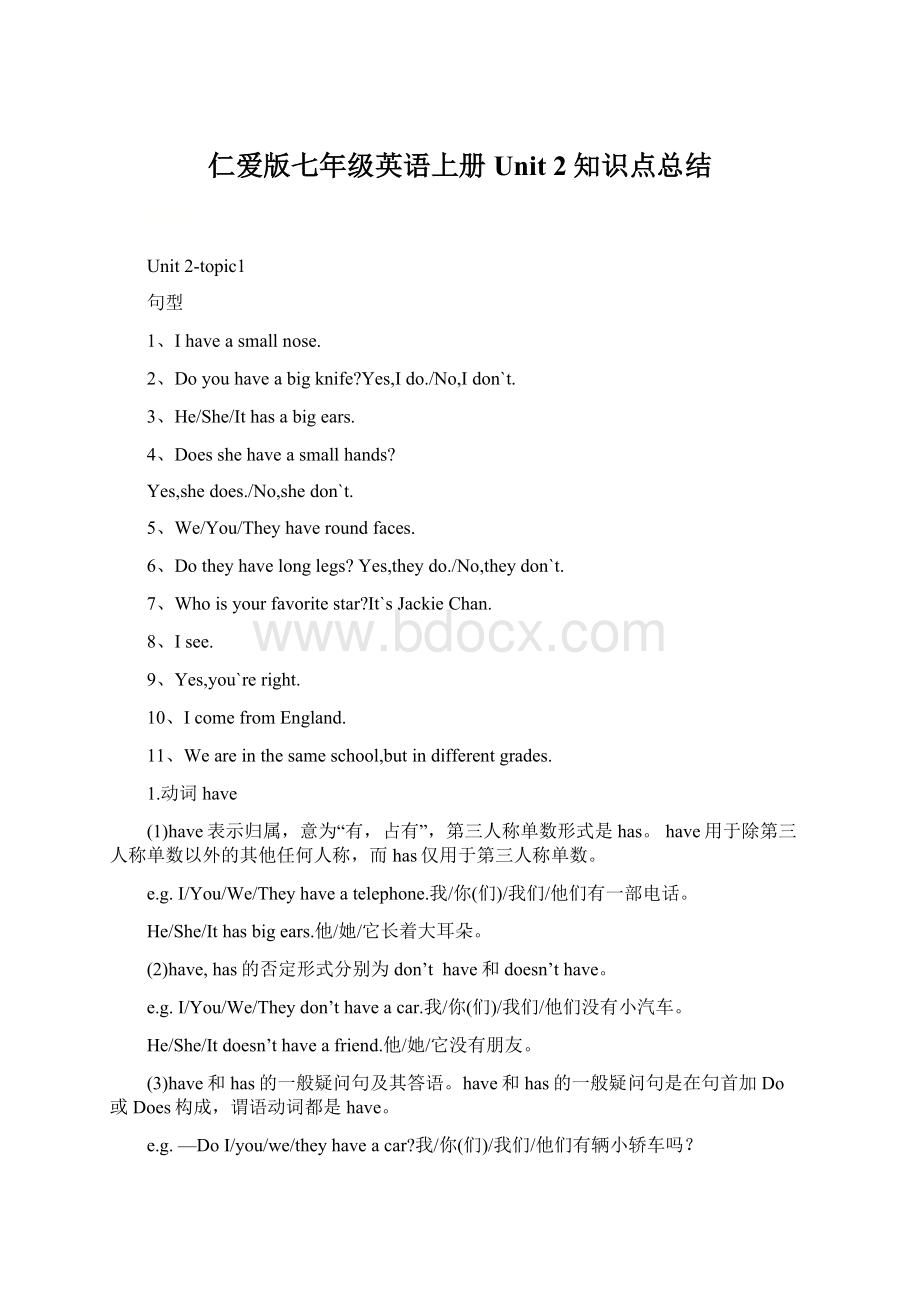仁爱版七年级英语上册Unit 2知识点总结Word格式文档下载.docx
《仁爱版七年级英语上册Unit 2知识点总结Word格式文档下载.docx》由会员分享,可在线阅读,更多相关《仁爱版七年级英语上册Unit 2知识点总结Word格式文档下载.docx(8页珍藏版)》请在冰豆网上搜索。

—Yes,you/I/we/theydo.是的,你(们)/我/我们/他们有。
—Doeshe/she/ithaveafriend?
他/她/它有朋友吗?
—Yes,he/she/itdoes.是的,他/她/它有。
2.形容词big/small,long/short大/小,长/短
形容词是表示人或事物特征的词,在句中主要用作定语或表语等。
e.g.Hehasabignose.他有一个大鼻子。
(定语)
Hisnoseisbig.他的鼻子大。
(表语)
Unit2-topic2
基本句型
1、Wedon`tlookthesame.=Welookdifferent.
2、Whatdoesshelooklike?
Sheistall.
3、WhatcoloristhatT-shirt?
It`sred.
4、Whatcolorarethoseshoes?
They`regreen.
5、PleasegivethislettertoMaria.
6、Oh,Isee.I`llgiveittoher.
7、Butyoulookthesame.
8、ThegirlinayellowdressisMaria.
9、Heisinablackcapandblueshoes.
1.特殊疑问句
特殊疑问句是就句子中的某一特定部分进行提问的问句。
特殊疑问句句末用问号,一般读降调。
(1)特殊疑问词
特殊疑问句都由疑问词引起,常用的疑问有who(谁),whose(的),which(哪一个),what(什么),when(何时),where(何地),why(为什么)和how(如何)等。
(2)特殊疑问句的语序
特殊疑问句的基本结构为:
疑问词+be/助动词/情态动词+主语+谓语/表语(+其他)?
e.g.
(1)—Whatisyourname?
你叫什么名字?
—MynameisLily.
我叫莉莉。
(2)
—Whoarethey?
他们是谁?
—Theyaremyfriends.
他们是我的朋友。
(3)
—WhereisKangkangfrom?
康康来自哪里?
—HeisfromChina.
他来自中国。
(4)
—Whichisyourbike?
哪辆自行车是你的?
—Thenewone.
新的那辆。
2.询问颜色及回答:
Whatcoloris/are...?
Itis/Theyare...
e.g.
(1)—Whatcoloristhedress?
这件连衣裙是什么颜色的?
—Itisred.
它是红色的。
(2)—Whatcolorareyourshoes?
你的鞋是什么颜色的?
—Theyarewhite.
它们是白色的。
3.looklike
与lookthesame
looklike...意为“看起来像……”,相当于belike,like是介词,后面通常接名词或代词。
e.g.
(1)Thegirllookslikemysister=Thegirlislikemysister.
这个女孩看起来像我的妹妹。
(2)—Whodoesshelooklike?
她看起来像谁?
—Shelookslikehermother.
她看起来像她的妈妈。
(3)—Whatdoesshelooklike?
/Whatisshelike?
她长得什么样?
—Sheistall./Shehastwobigeyesandasmallmouth.
她个子高。
/她长着两只大眼睛和一张小嘴巴。
lookthesame意为“看起来很像,看起来一样”,其后不跟名词或代词。
e.g.AandBlookthesame.A和B看起来一样。
Thetwobookslookthesame.
这两本书看起来一样。
4、Givesth.Tosb.=givesb.Sth.把某物给某人
e.g.Pleasegivethebooktome.=Pleasegivemethebook.请把这本书给我。
当某物用代词来指代时,必须把代词放在动词后面。
e.g.Giveittome.
5、shortblondhair”金黄色的短发”,当多个形容词修饰名词时,其顺序为:
数量+大小/长短+颜色+名词。
e.g.twobigredapples.
6、wanttodosth.想要做某事
Iwanttomeetanewfriend.
7、lookat看
8、inayellowdress
9、JaneisinapurpleT-shirtandapinkskirt.
inapurpleT-shirtandapinkskirt在句中作is的表语。
e.g.Kangkangisinawhitecoat.
10、Theyaregoodfriendsandtheylookhappy.
look在这里是系动词,happy是形容词,作look的表语,构成“系表”结构
e.g.Shelooksverybeautiful.
Unit2-topic3
1、Whosecapisit?
It`sSally`s.
2、Whosebananaarethese?
They`retheirbananas/theirs.
3、Welookthesame,butweareindifferentclothes.
4、Ithinkit`sKangkang`s.
物主代词
表示所有或所属关系的代词,叫物主代词,也称代词所有格。
物主代词分为名词性物主代词和形容词性物主代词两种。
形容词性
my
your
his
her
our
their
名词性
mine
yours
hers
ours
theirs
物主代词用法如下:
(1)形容词性物主代词必须置于名词前,修饰限定名词,作定语。
—What’syourname?
你叫什么名字?
—MynameisJane.
我叫简。
(2)名词性物主代词相当于“形容词性物主代词+名词”,在句子中主要是作主语、宾语和表语。
—Isthispenyours?
这支钢笔是你的吗?
—No,itisn’t.It`shis.
不,不是。
是他的。
Mineisonmydesk.
我的在我的课桌上。
(主语)
SheknowsmynameandIknowhers.
她知道我的名字,我也知道她的名字。
(宾语)
(3)名词前若有形容词性物主代词,不可再出现a,an,the,this,that,these,those之类的限定修饰词。
如果要表示这种意义,则用“of+名词性物主代词”这种结构。
e.g.afriendofmine
我的一个朋友
(4)whose既是形容词性物主代词,又是名词性物主代词。
e.g.Whoseisthisbook?
这本书是谁的?
(名词性物主代词)
Whosebookisthis?
这是谁的书?
(形容词性物主代词)
helpsb.(to)dosth.帮助某人做某事,“to”可以省略
Hehelpsme(to)learnEnglish.
【重点短语】
1.
givesb.sth.=givesth.tosb.把某物给某人
Please
giveittoher.
2.
look
thesame长相相同
lookdifferent长相不同,看起来不一样
3.
looklike看起来像
He
lookslike
hisfather.=Heandhisfather
lookthesame.
4.
nextto在……旁边
Theboy
nextto
meismygoodfriend.
5.
in+颜色
穿着……颜色的衣服
in+a/an+颜色+衣服
穿着……颜色的……
inayellowT-shirtandgraypants
ismygoodfriend.6.
(1)both两者都(be动词之后,实义动词之前)
Theybothhavebrownhairandblackeyes.
Theyarebothofficeworkers.
(2)all三者或三者以上都
Theyareallkindtome.
7.
数字+(形状、大小)+颜色+n.
two
bigredapples
Shehasshortblondhair.
【重点句型】
Who
is
yourfavoriteactor?
Weare
inthesameschool,
butweare
indifferentgrades.
Whatdo/does+主语+looklike?
……长得怎么样?
---Whatdoeshelooklike?
---Heisnotverytallbutverystrong.
Wedon’tlookthesame,butwearegood
friends.
We
lookthesame,butweare
indifferentclothes.
---Whatcoloris/are+主语?
---It’s/They’re+颜色.
---Whatcolorisherhair?
---It’sblond.
6.
Thisis
mycap.=Thiscapis
mine.
Isthisyourcap?
=Isthiscapyours?
---Whosecap
isthis?
=
Whoseisthis
cap?
---It’sSally’s.
---Whosearethesebananas?
---They’re
theirbananas/
theirs.
Hispantsareblueandmineare
white.(mine=mypants)
MyT-shirtisgreenandhis
brown.(his=hisT-shirt)
8.
Ihavesmalleyes,buthehasbigones.(ones指代eyes)
Myjacketisblueandwhite.Thatoneisblue.(one指代jacket)
【重点语法】
动词原形和动词第三人称单数形式
(1)主语是第三人称单数形式(he、she、it;
单一的人;
单一的名字;
单一的事物),动词要用单三形式。
实义动词变第三人称单数的规则:
①一般情况直接加“s”,如:
come---comes,meet---meets
②动词以o,s,sh,ch,x结尾,加“es”,如:
do--does;
go--goes;
teach--teaches
③以辅音字母+y结尾,变y为i,再加es,如:
study--studies,fly--flies,try--tries
④特殊情况:
have--has
(2)句型转换
①当主语为第三人称单数:
变否定句时,在动词前加doesn’t,动词现原形;
变一般疑问句时,在句首加does,动词现原形。
一般疑问句的肯定回答:
Yes,人称代词+does;
否定回答:
No,人称代词+doesn’t.
如:
Shehassmalleyes.
---Shedoesn’thavesmalleyes.
---Doesshehavesmalleyes?
---Yes,shedoes./No,shedoesn’t.
②当主语为第一、第二人称变否定句,在动词前加don’t,变一般疑问句,在句首加do,肯定回答:
Yes,人称代词+do;
No,人称代词+don’t.
Theyhavesmalleyes.
---Theydon’thavesmalleyes.
---Dotheyhavesmalleyes?
---Yes,theydo.
/
No,theydon’t.
2.表示所属关系
(1)名词性物主代词=形容词性物主代词+名词
形容词性物主代词
my
your
his
her
our
their
its
名词性物主代词
mine
yours
hers
ours
theirs
•
--Whoseisthispen?
Isityours?
--No,it’snotmine.Mypenisblue.
(2)名词所有格
①用于人或其他表示有生命的名词后:
单数或不以s结尾的复数+’s,如:
Jane’sbook;
Women’sDay
以s结尾的复数+’如:
Teachers’Day
Lucy’sandLily’sbags分有
LucyandLily’sroom共有
ThoseareJane’sshoes.=ThoseshoesareJane’s.
②of表示所属关系,用于没有生命的物体,如:
amapofChina;
a
photoofmyfamily